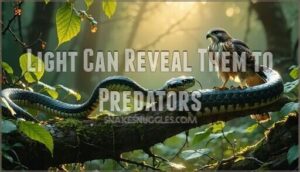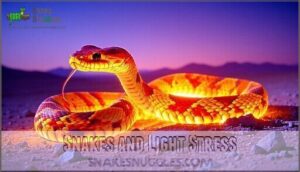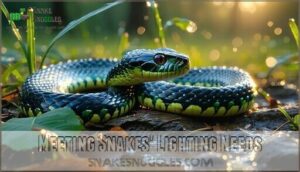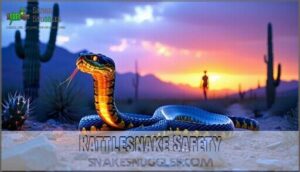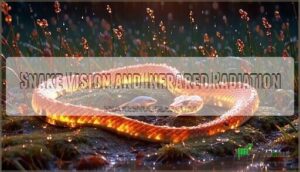This site is supported by our readers. We may earn a commission, at no cost to you, if you purchase through links.
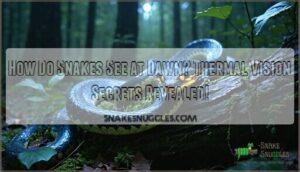
Snakes don’t rely on regular eyesight like you do. Instead, many species use specialized pit organs that detect infrared radiation – basically heat signatures from warm-blooded prey.
These incredible sensors work like thermal cameras, letting snakes "see" body heat even in complete darkness.
At dawn, when light levels are low, this superpower gives them a serious advantage over unsuspecting rodents and birds.
Their regular eyes also adapt quickly to changing light conditions, making them efficient hunters during those twilight hours when most animals are still rubbing sleep from their eyes.
There’s much more to this incredible sensory system than meets the eye.
Table Of Contents
- Key Takeaways
- How Do Snakes See at Dawn?
- Snakes’ Unique Vision
- Snakes’ Nocturnal Nature
- Snake Activity Patterns
- Snakes and Light Stress
- Meeting Snakes’ Lighting Needs
- Encountering Snakes on The Trail
- Rattlesnake Safety
- Snake Vision and Infrared Radiation
- Snakes in The Wild
- Snakes and Runners: Sharing The Path
- Frequently Asked Questions (FAQs)
- Can snakes see at the morning?
- How can you tell if a snake is around?
- What colors can snakes not see?
- What does a snakes vision look like?
- Are snakes active at dawn?
- How do snakes see during the day?
- What time of the day do snakes come out?
- Can snakes distinguish colors during dawn light conditions?
- How does a snakes vision adapt to rapidly changing light?
- Can snakes see UV light at dawn?
- Conclusion
Key Takeaways
- You’ll encounter snakes most often at dawn because they’re crepuscular hunters – they’re naturally wired for peak activity during twilight hours when their thermal vision gives them a serious advantage over warm-blooded prey.
- Snakes don’t rely on regular eyesight like you do – many species use specialized pit organs that detect infrared radiation, essentially giving them built-in thermal cameras that work like night-vision goggles even in complete darkness.
- Their eyes are incredibly sensitive to light changes – snake vision is 2,500 times better than yours in low-light conditions thanks to rod-heavy retinas packed with rhodopsin, making them perfect dawn hunters while avoiding harsh daylight.
- You should maintain at least six feet of distance if you encounter a snake – they’re not aggressive and prefer avoiding you, but respecting their space during dawn encounters keeps both you and the snake safe while they’re actively hunting.
How Do Snakes See at Dawn?
When you stumble across a snake at dawn, you’re witnessing nature’s most sophisticated thermal vision system in action.
These remarkable creatures don’t just rely on regular eyesight—they’ve evolved rhodopsin sensitivity that’s 2,500 times better than yours in low light conditions.
Snakes see 2,500 times better than you in darkness—nature’s ultimate night vision goggles.
Their crepuscular adaptations make them perfect twilight hunters, using specialized dawn vision to spot warm-blooded prey against cooler backgrounds.
Most snakes are naturally crepuscular, meaning they’re wired for peak activity during those magical golden hours.
Their sensitive eyes avoid harsh daylight, preferring the gentle illumination of sunrise and sunset.
This incredible snake eyesight combines traditional vision with heat-sensing abilities, creating a superpower that’s perfectly suited for dawn activity.
Think of it as having built-in night vision goggles that never need batteries!
Some species even exhibit UV-sensitive pigments, enhancing their vision in bright environments.
Snakes’ Unique Vision
You might think snakes just squint their way through dawn like you do on Monday mornings, but they’ve got something way cooler going on.
These amazing creatures use specialized pit organs that work like biological heat detectors, sensing infrared radiation from warm-blooded prey even when it’s pitch black outside, utilizing infrared radiation to locate their targets.
How Pit Organs Detect Infrared Radiation
Think of pit organs as nature’s thermal cameras – these specialized structures between a snake’s eyes and nostrils contain ultra-thin membranes that absorb infrared radiation from warm objects.
Nature’s biological heat sensors work like living thermal cameras, detecting warm prey in total darkness.
When heat hits these membranes, TRPA1 mechanism triggers nerve signals through infrared signal transduction, creating detailed thermal image processing that gives snakes incredible evolutionary advantages for heat detection during dawn hunts.
This allows them to sense even minute temperature changes with remarkable accuracy.
Pyroelectric Properties in Pit Organ Cells
Snake pit organs work like living thermometers with a twist—they’re pyroelectric materials that generate electricity when heated.
When dawn’s warmth hits these cellular membranes, thermal expansion shifts embedded charges, creating voltage changes your brain reads as heat signatures.
This electric signaling through temperature gradients gives crepuscular snakes their incredible dawn vision advantage.
These organs function through a sophisticated infrared radiation detection.
Role of TRPA1 Proteins in Infrared Sensing
While pyroelectric cells create the electrical foundation, TRPA1 proteins serve as the molecular switches that make snake infrared vision possible.
These specialized heat-sensing proteins are nature’s biological thermostats, concentrated heavily in pit organ cells.
When warm-blooded prey approaches, TRPA1 proteins detect temperature changes and trigger signal transduction pathways that send "heat alerts" straight to the snake’s brain.
Here’s how TRPA1 proteins revolutionize dawn vision:
- Heat thresholds: They’re incredibly sensitive, detecting temperature changes as small as 0.003°C
- Evolutionary origins: Three snake families independently evolved this superpower using TRPA1 activation
- Protein structure: Their unique molecular design acts like biological springs responding to thermal stimuli
- Signal transduction: They convert heat into electrical signals faster than you can blink
- Infrared vision: They transform ordinary snakes into heat-seeking missiles at dawn
This remarkable adaptation explains why pit organs make nocturnal hunting so effective.
Snakes’ Nocturnal Nature
You might be surprised to learn that most snakes don’t actually prefer the bright light of day—they’re night owls who come alive when the sun goes down.
These fascinating creatures have evolved as nocturnal or crepuscular animals, meaning they’re most active during dawn, dusk, or nighttime hours when their incredible thermal vision gives them a serious hunting advantage.
Most Snakes Are Nocturnal or Crepuscular
You’ll find most snakes embracing their nocturnal lifestyle, preferring dawn and dusk hunting over midday adventures.
These crepuscular creatures have perfected twilight activity patterns, using their specialized snake vision to navigate low-light conditions.
Their nocturnal adaptations and light sensitivity make dawn behavior ideal for crepuscular hunting, when prey is active but lighting won’t overwhelm their delicate eyes.
Light Can Reveal Them to Predators
Most nocturnal creatures live by stealth, but ironically, their specialized vision can betray them. When you’re perfectly adapted for darkness, daylight becomes your enemy in unexpected ways.
Glowing Eyes create the most obvious giveaway. That reflective shine you notice in animal eyes at night? It’s called tapetum lucidum, and while it helps snakes see better, it also acts like a beacon for hawk-eyed predators scanning the landscape.
Shadow Reveals present another challenge during dawn activity patterns. As the sun climbs higher, shadows shift and morph, turning perfect camouflage into stark silhouettes against rocks or vegetation.
Here’s how light compromises their predator avoidance strategies:
- Camouflage Issues arise when lighting changes disrupt carefully evolved patterns
- Movement contrast becomes magnified against bright backgrounds
- Heat signatures stand out more to predators with infrared detection
- Reflective scales can catch and scatter light unexpectedly
- Body positioning that worked in darkness suddenly looks obvious
Predator Vision varies widely too. Owls don’t just rely on sight—they’ve got incredible hearing and heat-sensing abilities. Even mammals like foxes can spot the subtle movements that crepuscular vision helps snakes make during their most active hunting periods.
It’s nature’s ultimate trade-off: enhanced snake vision for nighttime hunting comes with increased daytime vulnerability.
Their Eyes Are Sensitive to Bright Light
Brightness overwhelms snake vision like a floodlight in your eyes.
Their pupil constriction and rod saturation trigger immediate light avoidance behaviors at dawn.
Spectacle scales and melanin protection help, but light sensitivity remains intense.
This crepuscular vision adaptation explains why snakes retreat quickly when morning light disrupts their snake vision in low light capabilities, making dawn activity patterns brief.
Snake Activity Patterns
Most snakes follow predictable patterns throughout the day, with peak activity times that might surprise you.
You’ll find these fascinating creatures are most active during dawn and dusk hours, when their unique vision systems work at maximum efficiency to hunt prey and navigate their world.
Dawn and Dusk Activity Peaks
Ever wonder why you bump into snakes during your morning jog or evening walk?
These reptiles have mastered the art of crepuscular behavior, timing their activities perfectly with dawn and dusk when their snake vision works best. Dawn ectothermy helps them warm up while dusk sheltering prepares them for cooler nights.
Here’s why dawn activity observations reveal peak snake encounters:
- Crepuscular hunting maximizes prey availability when rodents and birds are most active
- Twilight vision gives them a competitive edge with enhanced infrared detection capabilities
- Transitional behavior allows ideal temperature regulation between day and night cycles
Burrowing Snakes and Their Schedules
While peak activity times are well-documented, burrowing snakes follow different rules entirely.
Their hidden schedules revolve around subterranean activity that you’ll rarely witness. These species use burrowing adaptations to exploit cooler underground temperatures, making snake activity patterns less predictable.
Limited visibility doesn’t stop their crepuscular behavior underground. Snake vision becomes secondary to tactile sensing in soil preferences they’ve mastered.
Snake behavior shifts dramatically when life happens beneath your feet.
Light Tolerance in Diurnal Species
Unlike their nocturnal cousins, diurnal snakes have mastered the art of daytime living through remarkable light adaptation strategies.
These sun-loving serpents showcase impressive Diurnal Adaptations that let them thrive when most snakes would retreat.
Protective Mechanisms help these species handle bright conditions:
- Enhanced visual acuity through specialized rods and cones that filter intense light
- Strategic Shade Seeking behaviors during peak afternoon heat
- Activity Peaks timed perfectly with cooler morning and evening hours
- Protective scale arrangements that shield sensitive eyes from UV damage
Their Light Sensitivity isn’t a weakness—it’s calibrated perfectly for their lifestyle.
While snake vision in nocturnal species relies heavily on infrared detection, diurnal snakes have evolved different visual priorities, balancing light tolerance with hunting efficiency in their sun-drenched world.
Snakes and Light Stress
While you can’t exactly stress out a snake like you’d a nervous hamster, too much bright light can definitely make them uncomfortable and affect their behavior.
Think of it like how you’d squint and feel cranky if someone kept shining a flashlight in your face—snakes experience something similar when exposed to harsh lighting for extended periods, which can be likened to how you’d feel if someone kept shining a flashlight in your face.
Light in Moderation is Okay
You don’t need to worry about perfect darkness for your snake’s wellbeing.
Moderate light won’t harm them, and it actually helps you monitor their health and behavior.
Their rod dominance and light sensitivity mean they’ll naturally seek dim light conditions when comfortable.
Think of it like having a friend who prefers cozy, softly-lit rooms over harsh fluorescents.
Just respect their eye protection needs by avoiding sudden bright lights.
Signs of Light-Induced Stress
Several warning signs indicate your snake’s struggling with light-induced stress.
Watch for hiding behavior – they’ll retreat more often than usual.
Appetite changes are common, with stressed nocturnal snakes refusing meals entirely.
You’ll notice erratic movements, excessive pupil constriction in bright conditions, and shedding issues.
Light sensitivity in crepuscular species shows through restless pacing and defensive posturing.
Tips for Appropriate Lighting
You’ll want to master light spectrum and intensity levels for your nocturnal snakes.
Use dim red lighting to preserve their natural low light vision without stressing snake eyes. Red reptile bulbs are a common choice for nocturnal viewing.
Control light duration with timers, mimicking natural cycles for crepuscular species.
Create proper basking spots while avoiding shadows that might confuse their snake vision patterns.
Meeting Snakes’ Lighting Needs
Whether you’re keeping pet snakes or studying them in the wild, understanding their lighting requirements is essential for their health and natural behavior.
You’ll need to balance their preference for dim conditions with their biological need for proper day-night cycles and essential UV exposure.
Choosing Habitats and Hiding Spots
Creating Safe Shelters for nocturnal snakes means offering diverse hiding options that support their natural Temperature Regulation needs.
Provide caves, hollow logs, and dense vegetation as Camouflage Spots that mimic wild Nocturnal Habitats.
These hideouts enable Predator Avoidance while giving snakes control over their environment, supporting their snake vision adaptations and natural snake behavior in darkness.
Providing Photoperiods
Behind all that fancy snake vision we’ve been talking about, photoperiods are your reptilian roommate’s internal clock. You’ll want to match light cycle length to your snake’s natural habitat, adjusting seasonal photoperiod changes throughout the year.
Here’s what makes photoperiods powerful for snake vision at dawn:
- Light sensitivity guides their daily hunting rhythms
- Nocturnal vision activation depends on darkness cues
- Brumation light cues trigger seasonal behavior changes
- Temperature gradient timing syncs with daylight patterns
Think 12-hour cycles as your starting point! Mimicking natural cycles requires appropriate bulb selection for ideal health.
Supplementing With Heat and UVB
Your snake needs proper heat gradients and UVB benefits to thrive.
Set up basking spots with infrared lamps that reach 85-95°F, creating warm zones for thermoregulation. Install UVB bulbs for vitamin D3 synthesis – replace every 6-12 months as effectiveness fades.
Consider specialized UVB bulbs to promote optimal reptile health.
Maintain natural light cycles with 12-hour photoperiods. During winter brumation needs, reduce lighting gradually to mimic seasonal changes for your nocturnal friend’s health.
Encountering Snakes on The Trail
Dawn brings the perfect opportunity to spot snakes on hiking trails, when their thermal vision gives them a hunting advantage but also makes encounters more likely.
You’ll want to know what to do when you cross paths with these remarkable creatures during your outdoor adventures.
What to Do if You See a Snake
Spotting a snake on your morning run? Don’t let snake encounters turn your peaceful trail time into a panic session. Stay calm – most snakes aren’t aggressive and prefer avoiding you too.
Here’s your game plan:
- Freeze immediately and locate the snake’s exact position
- Back away slowly without sudden movements or loud noises
- Give it space – snakes need an escape route just like you do
Avoid provoking the snake by throwing objects or attempting to identify species up close. Keep distance and remember: most snake myths about aggressive behavior are false.
If you can’t safely pass, seek help from park rangers. Smart trail safety beats bravado every time.
Keeping a Safe Distance
When you spot a snake, stay calm and back away slowly—safe distance means at least six feet or two snake lengths.
Most snake encounters happen because people get too close, so respect their space for effective bite prevention.
Your snake safety depends on understanding encounter protocols: freeze first, then create distance.
Remember, proper snake identification and habitat awareness help with predator avoidance and trail safety planning.
What if The Snake Doesn’t Move?
If you’re maintaining a safe distance but the snake hasn’t moved, don’t panic—it’s likely evaluating the situation too.
Snakes often freeze when they detect motion, relying on their camouflage effectiveness to avoid predator approach. Check for injury assessment signs like unusual positioning.
The snake might be in brumation state or displaying a defensive posture. Their reliance on motion detection is key to survival.
Give it time and space to leave naturally.
Rattlesnake Safety
When you’re out at dawn, rattlesnakes use their heat-sensing pits to spot you long before you see them, so it’s smart to know how to keep yourself safe.
With a little know-how and a watchful eye, you can avoid any surprise meetings—no need to test your sprinting skills against a snake.
Identifying Rattlesnakes
Trail encounters can turn serious when you spot these danger signs. Proper rattlesnake identification could save your life during dawn hikes when snake vision is most active.
Here’s your survival checklist for rattlesnake markings and identification:
- Head Shape – Look for that distinctive triangular, arrow-shaped head that’s wider than the neck
- Pit Location – Check for heat-sensing pits between the eyes and nostrils on each side
- Tail Rattles – Listen for the signature buzzing sound from segmented tail rattles
- Defensive Postures – Watch for coiled S-shaped positioning with raised head
- Visual Acuity – Notice their alert, focused snake eyes tracking your movement
These features distinguish venomous rattlers from harmless species during those critical moments when you need quick snake identification skills.
What to Do if Bitten
If a rattlesnake bites you, stay calm—panic won’t help!
Quick first aid can save your life:
- Stay calm and don’t move the bitten area
- Remove jewelry before swelling starts
- Mark swelling edges with a pen to track progression
- Seek help immediately—get to a hospital for antivenom
Remember, you can’t identify snake species by bite marks alone, so assume it’s venomous and get professional treatment fast!
Prevention Measures
Prevention’s your best friend here. Stick to wide paths and wear sturdy boots to avoid surprise encounters.
Make noise while hiking—crepuscular snakes rely on vibrations to detect you coming. Keep first-aid kits handy and know when to call for professional assistance.
Habitat modification around campsites reduces snake attraction. For exploring trails, consider purchasing hiking gear.
Smart snake prevention beats heroic snake safety stories every time.
Snake Vision and Infrared Radiation
You’ve probably wondered how snakes can hunt so effectively in the early morning twilight when most creatures can barely see their own feet.
While you’re squinting through the dim dawn light, snakes are busy converting invisible infrared radiation into precise electrical signals that paint a thermal picture of their world, allowing them to effectively hunt in low light conditions with their ability to convert infrared radiation into thermal signals.
Converting Infrared Into Electrical Signals
Here’s how snakes pull off their incredible thermal vision trick.
When infrared radiation hits their pit organs, cells act like tiny pyroelectric generators, creating electrical signals from heat changes.
TRPA1 activation opens ion channels, amplifying these signals before your brain interprets them as thermal images.
This evolutionary advantage gives snakes amazing nocturnal vision capabilities.
New Insights Into Snake Vision
Recent breakthroughs reveal how snake vision works beyond basic sight.
Scientists discovered that spectacle scales protect eyes while allowing UV detection through specialized visual pigments.
Their spherical lens design maximizes light gathering for nocturnal snakes.
Dichromatic vision combines with thermal vision capabilities, giving snakes incredible infrared vision for precise snake hunting at dawn.
Here’s what makes snake vision extraordinary:
- Spectacle scales act like built-in contact lenses that never need cleaning
- Visual pigments detect both UV light and thermal signatures simultaneously
- Spherical lens structure captures 2,500 times more light than human eyes
The Role of Pyroelectric Materials
Nature’s thermal detectors work through fascinating pyroelectric mechanisms that’ll blow your mind.
When temperature changes hit pit organs, these materials generate electric charge automatically – it’s like having biological batteries!
Here’s how infrared detection works:
- Material composition creates temperature sensitivity in specialized cells
- Pyroelectric properties convert heat into electrical signals instantly
- Thermal imaging gives snakes nocturnal vision that beats night-vision goggles
Snakes in The Wild
When you’re out hiking at dawn, you might spot snakes taking advantage of those perfect twilight conditions.
These incredible creatures play essential roles in their ecosystems, from controlling rodent populations to serving as prey for larger predators like hawks and owls, which is a critical part of the ecosystem balance.
Regional Snake Species
Your backyard might host harmless garter snakes, while desert regions showcase rattlesnakes with specialized snake vision adaptations.
Regional species vary dramatically – from nocturnal behavior in rat snakes to diurnal behavior in racers.
Understanding Local Snake ID helps distinguish between species in Venomous Regions versus safer Snake Habitats.
| Region | Common Species | Activity Pattern |
|---|---|---|
| North America | Garter, Rat, Rattlesnake | Crepuscular/Nocturnal |
| Desert Southwest | Diamondback, Coral Snake | Dawn/Dusk Active |
| Eastern Woodlands | Copperhead, Black Snake | Nocturnal behavior |
| Wetlands | Cottonmouth, Water Snake | Diurnal behavior |
Regional Adaptations reflect local prey and climate, affecting Conservation Status and snake vision at night capabilities.
Snakes and Their Role in The Ecosystem
You’ll find snakes are nature’s unsung heroes, silently maintaining ecosystem balance through remarkable pest control services.
These serpentine predators keep rodent populations in check, preventing crop damage and disease spread that could cost farmers billions annually.
Swamp snakes, for example, are essential for wetland ecosystem balance.
- Pest Control Champions: A single snake can consume hundreds of rodents yearly, protecting agricultural crops and reducing disease transmission
- Food Web Anchors: Snake ecosystems support biodiversity by serving as both predator and prey, maintaining delicate ecological relationships
- Conservation Indicators: Healthy snake populations signal thriving environments, making conservation efforts crucial for overall biodiversity impact
Respecting Snakes and Their Habitat
Snake habitats deserve our respect—you’re visiting their home, not the other way around.
Practice coexistence strategies by maintaining a safe distance and observing responsibly. Dispelling myths helps promote habitat preservation while supporting their nocturnal nature.
| Respectful Hiking Practice | Why It Matters | Real Impact |
|---|---|---|
| Keep 6+ feet distance | Reduces stress on snakes | Prevents defensive strikes |
| Stay on marked trails | Protects snake habitats | Preserves ecosystem balance |
| No flash photography | Respects nocturnal nature | Avoids disrupting behavior |
| Leave no trace behind | Maintains habitat quality | Supports long-term conservation |
Snakes and Runners: Sharing The Path
As a runner, you’ll likely encounter snakes during dawn hours when both you and they’re most active on the trails.
Understanding their incredible thermal vision and behavior patterns helps you stay safe while appreciating these remarkable creatures.
They play essential roles in controlling rodent populations along your favorite running routes, which is a key aspect to consider for a safe and enjoyable running experience, highlighting the importance of remarkable creatures.
Snake Safety for Runners
When you’re out running, dawn and dusk present peak snake activity times.
Stay alert during these hours when snake vision and thermal detection abilities are most active. Use Trail Awareness to spot movement ahead.
Snake Identification becomes harder in low light, so maintain distance from any serpentine shapes.
Running Gear like sturdy shoes helps protect against strikes. If you can’t identify a species, assume it’s venomous.
Encounter Avoidance means giving snakes space to retreat—they’re hunting or seeking shelter, not looking for trouble with runners.
Benefits of Snakes in The Ecosystem
Beyond their striking appearance, you’ll find snakes serve as nature’s unsung heroes in maintaining ecological balance.
These remarkable predators tackle pest control like professional exterminators, with some species consuming hundreds of rodents annually.
Their ecosystem role extends far beyond simple hunting:
- Pest Control – Reducing agricultural damage by eliminating destructive rodent populations
- Ecosystem Balance – Preventing overpopulation of small animals that disrupt plant growth
- Biodiversity Support – Facilitating seed dispersal through their extensive hunting ranges
- Carrion Removal – Cleaning up deceased animals to prevent disease spread
Learning From Snake Encounters
Every trail encounter teaches you something new about snake behavior and visual capabilities.
These moments build encounter preparedness while reducing fear reduction through understanding.
Habitat awareness grows as you observe where snakes rest during dawn hours, using their nocturnal vision and sensory abilities for snake prey detection.
Snake identification skills improve with each sighting, fostering conservation ethics and respect for their role in nature’s balance.
| What You Learn | How It Helps | Long-term Benefit |
|---|---|---|
| Snake movement patterns | Better trail awareness | Increased confidence outdoors |
| Habitat preferences | Predictable encounter zones | Safer running routes |
| Body language cues | Threat assessment skills | Reduced panic responses |
| Species identification | Venomous vs. harmless recognition | Appropriate reaction timing |
| Seasonal behavior | Activity pattern knowledge | Year-round preparedness |
Frequently Asked Questions (FAQs)
Can snakes see at the morning?
Like tuning into your favorite AM radio station back in the day, you’ll find snakes excel at morning vision.
Their rod-heavy retinas detect movement and light exceptionally well at dawn, while infrared-sensing pit organs help certain species spot warm prey.
How can you tell if a snake is around?
You’ll spot snakes by watching for movement in grass, listening for rustling sounds, or seeing their distinctive slithering tracks in dirt.
Look for shed skins nearby and check warm spots like sunny rocks or concrete where they bask, often seeking warm areas.
What colors can snakes not see?
Most snakes can’t see red colors well since they typically have only one type of cone cell that detects blue light, giving them limited dichromatic vision.
Compared to humans’ full-color spectrum.
What does a snakes vision look like?
You’ll see a world that’s heavily focused on movement and heat rather than sharp colors.
Their vision combines regular eyesight with thermal sensing, creating a unique overlay where warm objects glow against cooler backgrounds.
Are snakes active at dawn?
Dawn’s early light awakens nature’s silent hunters from their nighttime rest.
You’ll find snakes are most active during these twilight hours, using their exceptional low-light vision and infrared sensing to hunt warm-blooded prey effectively, which makes them highly efficient hunters.
How do snakes see during the day?
During daylight hours, you’ll find that snakes rely on their rod-dominated retinas and spherical lenses for sharp vision.
They see movement exceptionally well but have limited color perception compared to humans.
What time of the day do snakes come out?
Most snakes are crepuscular, meaning they’re active during dawn and dusk when temperatures are moderate. You’ll encounter them most frequently during these twilight hours when they hunt for food.
Can snakes distinguish colors during dawn light conditions?
While you won’t catch them rainbow-watching like parrots, snakes can’t distinguish colors well during dawn’s dim light.
Their eyes rely heavily on rod cells for light detection rather than cone cells for color vision, making dawn hunting about movement and heat detection instead.
How does a snakes vision adapt to rapidly changing light?
Your snake’s eyes adjust to dawn’s shifting light through specialized rod cells packed with rhodopsin that regenerates quickly after breaking down in bright conditions.
While their vertical slit pupils contract rapidly to protect sensitive retinas.
Can snakes see UV light at dawn?
Yes, you’ll find that pythons can detect UV light at dawn thanks to their double-layer rod receptors.
This UV vision helps them spot prey and navigate as darkness shifts to daylight during those vital hunting hours.
Conclusion
Understanding how do snakes see at dawn reveals nature’s most sophisticated hunting technology.
You’ve discovered that these remarkable predators combine thermal imaging with light-sensitive vision, creating an almost unfair advantage over their prey.
Whether you’re hiking at sunrise or simply fascinated by evolution’s ingenuity, remember that snakes aren’t just surviving in low-light conditions—they’re thriving.
Next time you witness dawn breaking, you’ll appreciate the invisible heat signatures dancing around you, visible only to these incredible thermal hunters sharing our world.
- https://snakesplash.com/how-snake-vision-differs-from-day-to-night3053/
- https://www.nhm.ac.uk/discover/news/2016/september/study-sheds-light-on-snake-vision.html
- https://animalresearcher.com/snakes-infrared-night-vision/
- https://en.wikipedia.org/wiki/Infrared
- https://www.ncbi.nlm.nih.gov/pmc/articles/PMC4869740/





